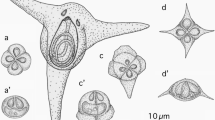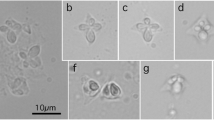Abstract
Genetic characterization of myxosporean species, including members of the genus Kudoa, has advanced dramatically throughout the last decade. This is in stark contrast to those species described further back in time. Kudoa musculoliquefaciens described from the jellied muscle of swordfish, Xiphias gladius, in the western Pacific Ocean off the Sanriku Coast, northern Japan, is one such species. In the present study, multiple pseudocysts (0.66–1.35 mm average length and 0.06–0.10 mm average width) containing K. musculoliquefaciens spores were collected from three host groups: muscle blocks of swordfish caught in the western Pacific Ocean off the Sanriku Coast, or the northern Indian Ocean, and Indo-Pacific sailfish, Istiophorus platypterus, in the western Pacific Ocean off Kochi, western Japan. Subspherical K. musculoliquefaciens spores, 8.0–10.3 μm in width, 7.3–10.0 μm in thickness, 6.4–7.9 μm in sutural thickness, and 5.5–8.1 μm in length, had four subspherical polar capsules, 2.8–4.0 μm in length by 2.2–3.2 μm in width. The kudoid spores found in the different host groups showed morphometric variations to some extent but had essentially identical nucleotide sequences of the ribosomal RNA gene (rDNA), closest to those of Kudoa hemiscylli or Kudoa carcharhini recorded from elasmobranchs in the Indo-Pacific Ocean. Another kudoid species, Kudoa pleurogrammi n. sp., was recorded from the jellied and normal muscles of Atka mackerel, Pleurogrammus monopterygius and Pleurogrammus azonus, fished in the northern Pacific Ocean or northern Sea of Japan. Subquadrate spores found in round-ended pseudocysts (1.15–3.85 mm in length and 0.11–0.26 mm in width) in myofibers were 8.2–9.1 μm in width, 7.1–8.2 μm in thickness, 5.4–7.7 μm in sutural thickness, and 5.6–6.8 μm in length, with four ovoid polar capsules, 2.7–2.9 μm in length by 1.4–2.0 μm in width. Kudoid spores from both jellied and normal muscles or different host fish species had identical 18S or 28S rDNA nucleotide sequences. Thus, molecular genetic characterization of kudoid species with the potential to induce post-mortem myoliquefaction will facilitate the reliable and specific identification of myxosporeans found in either jellied or normal muscles of important commercial fish.






Similar content being viewed by others
References
Abdel-Ghaffar F, Bashtar AR, Mehlhorn H, Al-Rasheid K, Al-Olayan E, Abdel-Baki AA, Morsy K (2009) Ultrastructure and host parasite relationships of Kudoa pagrusi (Myxozoa) infecting the heart muscles of sea bream Pagrus pagrus (L.) from the Red Sea. Parasitol Res 106:121–129
Abdel-Ghaffar F, Morsy K, Mehlhorn H, Bashtar AR, Shazly MA, Saad AH, Abdel-Gaber R (2012) First report of Kudoa species (Myxozoa: Kudoidae) infecting the spotted coral grouper Plectropomus maculates from the Red Sea. A light and ultrastructural study. Parasitol Res 111:1579–1585
Al Quraishy S, Koura E, Abdel-Baki AS, Bashtar AR, El Deed N, Al Rasheid K, Abdel Ghaffar F (2008) Light and electron microscopic studies on Kudoa pagrusi sp. n. (Myxosporea: Multivalvulida) infecting the heart of sea bream Pagrus pagrus (L.) from the Red Sea. Parasitol Res 102:205–209
Al Quraishy S, Koura E, Abdel-Baki AS, Bashtar AR, El Deed N, Al Rasheid K, Abdel Ghaffar F (2011) Erratum to: Light and electron microscopic studies on Kudoa pagrusi sp. n. (Myxosporea: Multivalvulida) infecting the heart of sea bream Pagrus pagrus (L.) from the Red Sea. Parasitol Res 108:1593–1594
Anisimova M, Gascuel O (2006) Approximate likelihood-ratio test for branches: a fast, accurate, and powerful alternative. Syst Biol 55:539–552
Aseeva NL (2004) New species of Myxosporea from the genus Kudoa (Myxosporea, Multivvalvulida) found in muscles of some fishes of the Sea of Japan. Vestn Zool 2:75–77
Burger MAA, Adlard RD (2010) Phenotypic variation in a significant spore character in Kudoa (Myxosporea: Multivalvulida) species infecting brain tissue. Parasitology 137:1759–1772
Burger MAA, Adlard RD (2011) Low host specificity in the Kudoidae (Myxosporea: Multivalvulida) including seventeen new host records for Kudoa thalassomi. Folia Parasitol 58:1–16
Campbell N (2005) The myxosporean parasitofauna of the Atlantic horse mackerel, Trachurus trachurus (L.) in the North-East Atlantic Ocean and Mediterranean Sea. Acta Parasitol 50:97–101
Dereeper A, Guignon V, Blanc G, Audic S, Buffet S, Chevenet F, Dufayard JF, Guindon S, Lefort V, Lescot M, Claverie J-M, Gascuel O (2008) Phylogeny.fr: robust phylogenetic analysis for the non-specialist. Nucleic Acids Res 36:465–469
Dyková I, Avila EJF, Fiala I (2002) Kudoa diannae sp. n. (Myxosporea: Multivalvulida), a new parasite of bullseye puffer, Sphoeroides annulatus (Tetraodontiformes: Tetraodontidae). Folia Parasitol 49:17–23
Dyková I, de Buron I, Fiala I, Roumillat WA (2009) Kudoa inornata sp. n. (Myxosporea: Multivalvulida), from the skeletal muscles of Cynoscion nebulosus (Teleostei: Sciaenidae). Folia Parasitol 56:91–98
Egusa S (1986) Multivalvulid myxosporeans, particularly Kudoa spp. Fish Pathol 21:261–274 (in Japanese)
Eiras JC, Saraiva A, Cruz C (2014) Synopsis of the species of Kudoa Meglitsch, 1947 (Myxozoa: Myxosporea: Multivalvulida). Syst Parasitol 87:153–180
Gleeson RJ, Bennett MB, Adlard RD (2010) First taxonomic description of multivalvulidan myxosporean parasites from elasmobranchs: Kudoa hemiscylli n. sp. and Kudoa carcharhini n. sp. (Myxosporea: Multivalvulidae). Parasitology 137:1885–1898
Guindon S, Gascuel O (2003) A simple, fast, and accurate algorithm to estimate large phylogenies by maximum likelihood. Syst Biol 52:696–704
Harada T, Kawai T, Jinnai M, Ohnish T, Sugita-Konishi Y, Kumeda Y (2012a) Detection of Kudoa septempunctata 18S ribosomal DNA in patient fecal samples from novel food-borne outbreaks caused by consumption of raw olive flounder (Paralichthys olivaceus). J Clin Microbiol 50:2964–2968
Harada T, Kawai T, Sato H, Yokoyama H, Kumeda Y (2012b) Development of a quantitative polymerase chain reaction assay for detection of Kudoa septempunctata in olive flounder (Paralichthys olivaceus). Int J Food Microbiol 156:161–167
Heiniger H, Cribb TH, Adlard RD (2013) Intra-specific variation of Kudoa spp. (Myxosporea: Multivalvulida) from apogonid fishes (Perciformes), including the description of two new species, K. cheilodipteri n. sp. and K. cookii n. sp., from Australian waters. Syst Parasitol 84:193–215
Kasai A, Li Y-C, Setsuda A, Mafie E, Sato H (2015) Genetic characterization of Kudoa iwatai and Kudoa trachuri in commercial marine fish (Platycephalus sp. and Trachurus japonicus) for human consumption. Jpn J Vet Parasitol 14:22–30
Kawai T, Sekizuka T, Yahata Y, Kuroda M, Kumeda Y, Iijima Y, Kamata Y, Sugita-Konishi Y, Ohnishi T (2012) Identification of Kudoa septempunctata as the causative agent of novel food poisoning ourbreasks in Japan by consumption of Paralichthys olivaceus in raw fish. Clin Infect Dis 54:1046–1052
Konagaya S (1983) Protease responsible for jellification of Myxosporidia-infected swordfish meat. Bull Jpn Soc Sci Fish 49:919–926 (in Japanese with English summary)
Kristmundsson Á, Freeman MA (2014) Negative effects of Kudoa islandica n. sp. (Myxosporea: Kudoidae) on aquaculture and wild fisheries in Iceland. Int J Parasitol Parasites Wildl 3:135–146
Kudo G, Barnett HJ, Nelson RW (1987) Factors affecting cooked texture quality of Pacific whiting, Merluccius productus, fillets with particular emphasis on the effects of infection by the myxosporeans Kudoa paniformis and K. thyrsitis. Fish Bull 85:745–756
Li Y-C, Sato H, Kamata Y, Ohnishi T, Sugita-Konishi Y (2012) Three novel myxobolid species of genera Henneguya and Myxobolus (Myxosporea: Bivalvulida) from marine fish in Japan. Parasitol Res 111:819–826
Li Y-C, Sato H, Tanaka S, Ohnishi T, Kamata Y, Sugita-Konishi Y (2013) Characterization of the ribosomal RNA gene of Kudoa neothunni (Myxosporea: Multivalvulida) in tunas (Thunnus spp.) and Kudoa scomberi n. sp. in a chub mackerel (Scomber japonicus). Parasitol Res 112:1991–2003
Lom J, Arthur JR (1989) A guideline for the preparation of species descriptions in Myxosporea. J Fish Dis 12:151–156
Lom J, Dyková I (2006) Myxozoan genera: definition and notes on taxonomy, life-cycle terminology and pathogenic species. Folia Parasitol 53:1–36
Matsukane Y, Sato H, Tanaka S, Kamata Y, Sugita-Konishi Y (2010) Kudoa septempunctata n. sp. (Myxosporea: Multivalvulida) from an aquacultured olive flounder (Paralichthys olivaceus) imported from Korea. Parasitol Res 107:865–872
Matsukane Y, Sato H, Tanaka S, Kamata Y, Sugita-Konishi Y (2011) Kudoa iwatai and two novel Kudoa spp., K. trachuri n. sp. and K. thunni n. sp. (Myxosporea: Multivalvulida), from daily consumed fish in western Japan. Parasitol Res 108:913–926
Matsumoto K (1954) On the two new Myxospridia, Chloromyxum musculoliquefaciens sp. nov. and Neochloromyxum cruciformum gen. et sp. nov., from the jellied muscle of swordfish, Xiphias glandius Linné, and Lateolabrax japonicus (Temmink et Schlegel). Bull Jpn Soc Sci Fish 20:469–478
Moran JDW, Whitaker DJ, Kent ML (1999) A review of the myxosporean genus Kudoa Meglitsch, 1947, and its impact on the international aquaculture industry and commercial fisheries. Aquaculture 172:163–196
Sato H (2011) Biology of the Myxozoa, a newly recognized parasitic pathogen causing food poisoning. Yamaguchi J Vet Med 38:1–26 (in Japanese with English summary)
Sato H (2013) A conflict between morphological and molecular phylogenetic classification of Myxosporea. Jpn J Vet Parasitol 12:105–116 (in Japanese with English summary)
Sugita-Konishi Y, Sato H, Ohnishi T (2014) Novel foodborne disease associated with consumption of raw fish, olive flounder (Paralichthys olivaceus). Food Safety 2:141–150
Suzuki J, Murata R, Sadamasu K, Kai A (2012) Cases of food poisoning caused possibly by Kudoa spp. in the Tokyo metropolitan area. IASR 33:153–155 (in Japanese)
Suzuki J, Murata R, Yokoyama H, Sadamasu K, Kai A (2015) Detection rate of diarrhoea-causing Kudoa hexapunctata in Pacific bluefin tuna Thunnus orientalis from Japanese waters. Int J Food Microbiol 194:1–6
Thompson JD, Higgins DG, Gibson TJ (1994) CLUSTAL W: Improving the sensitivity of progressive multiple sequence alignment through sequence weighting, position-specific gap penalties and weight matrix choice. Nucleic Acids Res 22:4673–4680
Tomochi H, Li Y-C, Tran BT, Yanagida T, Sato H (2014) Three Unicapsula species (Myxosporea: Trilosporidae) of Asian marine fishes, including the description of Unicapsula setoensis n. sp. in the yellowfin goby (Acanthogobius flavimanus) from the Inland Sea of Japan. Parasitol Res 113:3807–3816
Whipps CM, Kent ML (2006) Phylogeography of the cosmopolitan marine parasite Kudoa thyrsites (Myxozoa: Myxosporea). J Eukaryot Microbiol 53:364–373
Whipps CM, Grossel G, Adlard RD, Yokoyama H, Bryant MS, Munday BL, Kent ML (2004) Phylogeny of the Multivalvulidae (Myxozoa: Myxosporea) based on comparative ribosomal DNA sequence analysis. J Parasitol 90:618–622
Widera L (1976) The evaluation of a sanitary quality of Pleurogrammus monopterigius meat infested with Kudoa parasites. Med Weter 32:232–234 (In Polish with English summary)
Yokoyama H, Whipps CM, Kent ML, Mizuno K, Kawakami H (2004) Kudoa thyrsites from Japanese flounder and Kudoa lateolabracis n. sp. from Chinese sea bass: Ccausative myxozoans of post-mortem myoliquefaction. Fish Pathol 39:79–85
Acknowledgments
We are indebted to Prof. Shuhei Tanaka, Faculty of Agriculture, Yamaguchi University, for his help with the scanning electron microscopy. This study was supported in part by a Grant-in-Aid for Scientific Research 2015 from The Towa Foundation for Food Science and Research to H. S. and by JSPS KAKENHI grant number 15K07722.
Author information
Authors and Affiliations
Corresponding author
Rights and permissions
About this article
Cite this article
Kasai, A., Li, YC., Mafie, E. et al. Morphological and molecular genetic characterization of two Kudoa spp., K. musculoliquefaciens, and K. pleurogrammi n. sp. (Myxosporea: Multivalvulida), causing myoliquefaction of commercial marine fish. Parasitol Res 115, 1883–1892 (2016). https://doi.org/10.1007/s00436-016-4928-2
Received:
Accepted:
Published:
Issue Date:
DOI: https://doi.org/10.1007/s00436-016-4928-2




